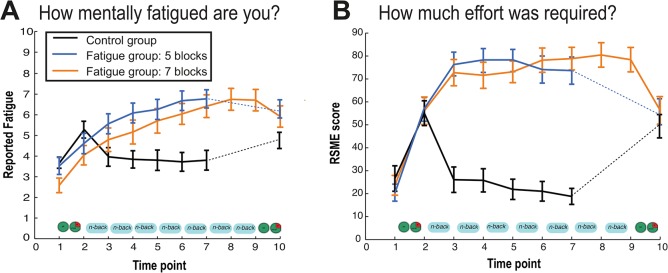The order of Figs 2 and 3 is switched. Please view the correct Fig 2 and Fig 3 here. The publisher apologizes for the error.
Fig 2. Cognitive fatigue ratings.

State fatigue and effort across the experimental protocol. The fatigue (orange bars) and control groups (light and dark blue bars: 5-blocks and 7-blocks of N-back respectively) did not differ significantly in (A) self-reported cognitive fatigue pre- manipulation and (B) RSME scores, at baseline. However, post- manipulation, the fatigue group reported significantly higher cognitive fatigue and RSME scores as compared to the non-fatigue group, suggesting that the manipulation was successful in inducing fatigue in the fatigue groups.
Fig 3. Example choice functions.
(A) In the gains domain, the range of risk preferences is represented on a continuum from risk seeing (left) to risk averse (right). The indifference point of each choice function is marked with a red inverted-triangle. Risk premium is determined by the value on the ‘(rEVG / Vc) -1’ (x-axis) at this indifferent point. (B) In the losses domain, the range of risk preferences is represented on a continuum from risk averse (left) to risk seeking (right).
Reference
- 1. Mullette-Gillman OA, Leong RLF, Kurnianingsih YA (2015) Cognitive Fatigue Destabilizes Economic Decision Making Preferences and Strategies. PLoS ONE 10(7): e0132022 doi:10.1371/journal.pone.0132022 [DOI] [PMC free article] [PubMed] [Google Scholar]



